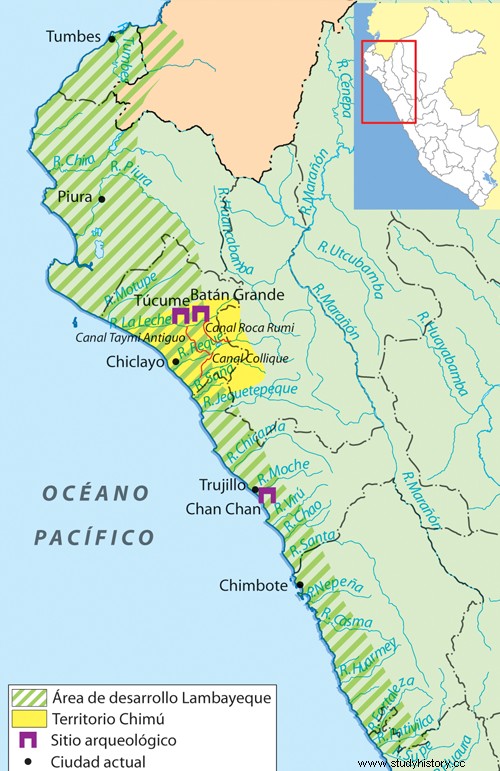 Geographical location map of Lambayeque
Geographical location map of Lambayeque MYTHICAL ORIGIN The origins of this culture are related to the legend of Nailamp, Naimlap or Ñañlap, who is represented as an ornithomorphic God (figure of Bird), since the root "ñain" means bird. According to legend, this monarch arrived in an army of rafts to the coast of Lambayeque accompanied by a large court. He landed on the Lambayeque river and "entering the land with his men, he built some palaces - which many identify with the Huaca Chotuna - which his descendants called Chot, enthroning there the civilizing hero the cult of the Yampallec idol, from which the name of Lambayeque derived. Naylamp died after many years of reign (time in which they say wings were born, bird attributes with which he was going to be represented in the future), but his faithful servants, to prevent the common people from believing him mortal, buried his body in the room where he slept, later claiming that he had flown to heaven.The successor line remained, however, in Cium - the firstborn of Nailamp - who was succeeded by Escuñain, Mascuy, Cuntipallec, Allascunti, Nofannech, Mulumuslan, Calleco, Lanipat - Cum, Acunta and Fampellec, all monarchs of Lambayeque and the last one assassinated by his subjects who threw him into the sea due to his many vices and alliances with the devil. (J. Del Busto D.- Pre-Inca Peru).
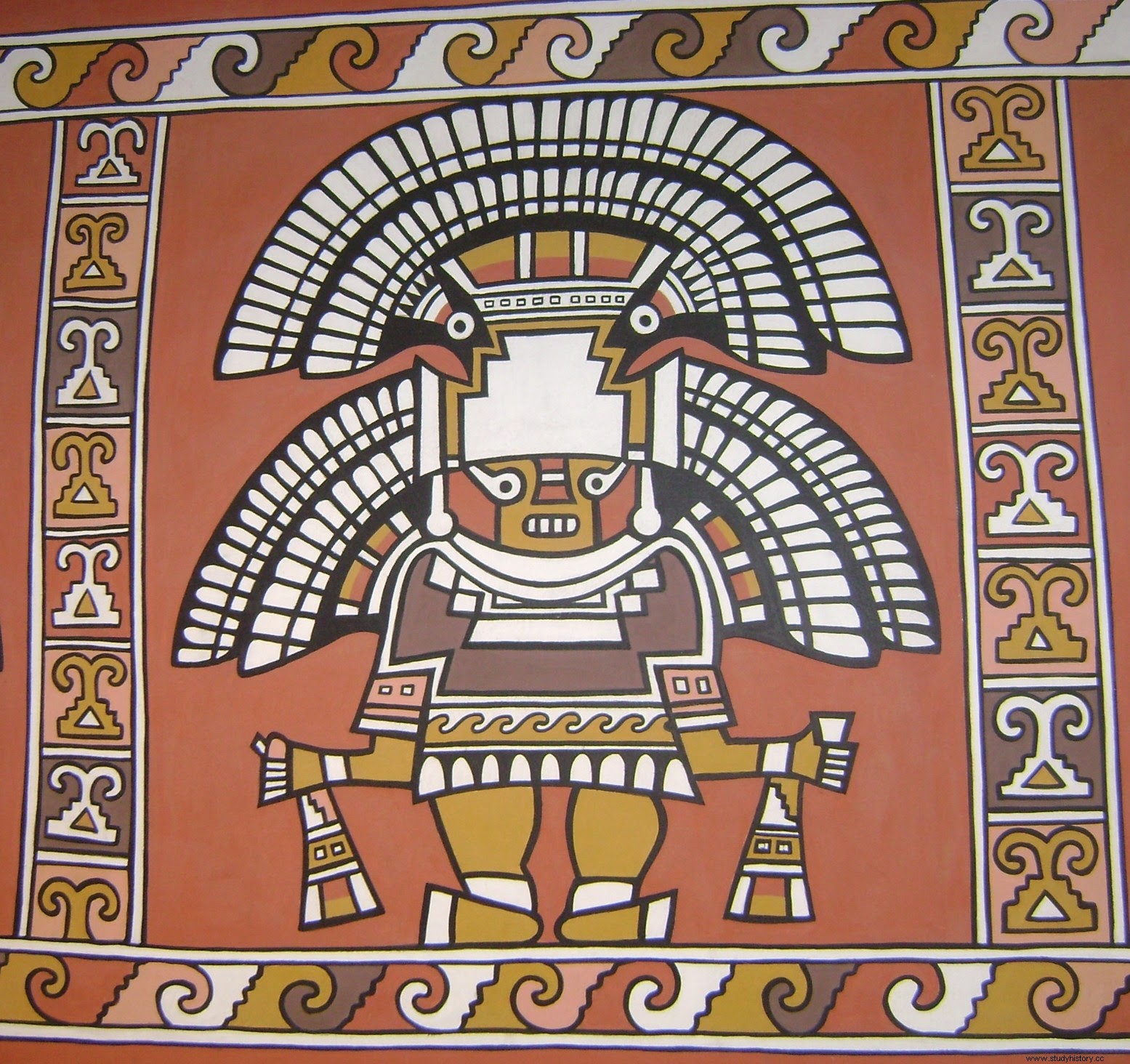 Naylamp representation
Naylamp representation 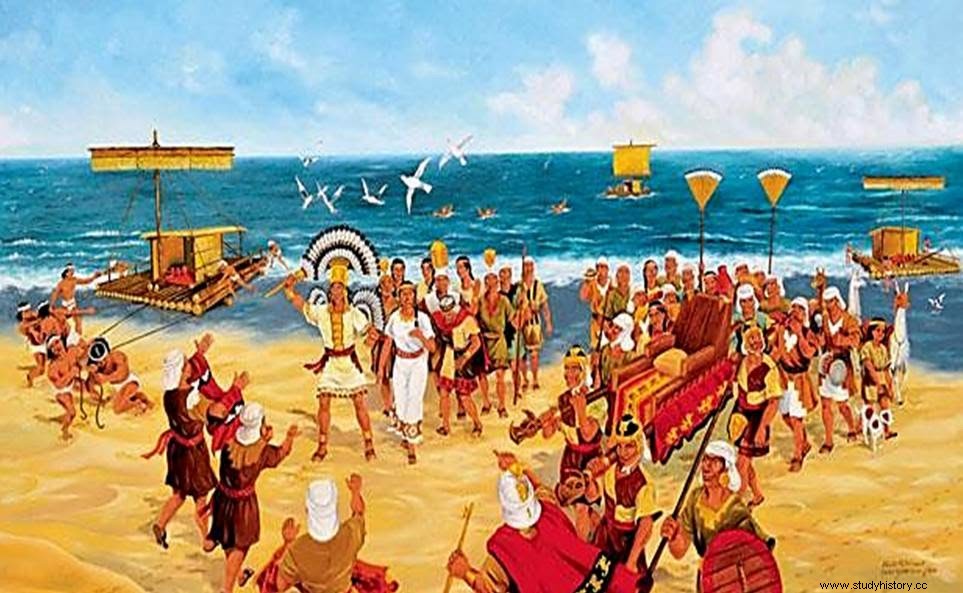 Representation of Naylamp's arrival on the Peruvian coast PERIODS In the muchik Sican language it means "house of the moon" or Lambayeque. The archaeologist Isumi Shimada divides the Sicán culture into three periods.
Representation of Naylamp's arrival on the Peruvian coast PERIODS In the muchik Sican language it means "house of the moon" or Lambayeque. The archaeologist Isumi Shimada divides the Sicán culture into three periods.1. EARLY SICAN. (750 – 900 years AD), is characterized by the Wari influence. His center of power was Batán Grande (adobe and stone). 2. MEDIUM SICAN. (900-1100 years A.D.), time of peak and remarkable cultural development. In religion, the Lord of Sicán stands out, who is represented in the gold Tumi.3. LATE SICAN. (1100-1300 years AD), characterized by the existence of torrential rains, a new political center known as Túcume was founded, but around the year 1300 they were conquered by the Chimú.
POLITICAL - SOCIAL ORGANIZATION It was a slave-owning, classist society with a theocratic-militarist state and government. The political character of Lambayeque was that of a theocratic state with a highly stratified social structure made up of an elite based on family ties with a divine origin, a body of administrators, a group of artisans and farmers. Although there was a certain independence between these groups, cohesion was provided by a series of ritual and kinship alliances, which was the basis of the power structure. One of the proofs of the power and complexity of Lambayeque society are the magnificent royal tombs, where abundant spondylus and gold have been found. Another element are the truncated-pyramidal architectural complexes with access ramps and murals painted with motifs of birds and marine scenes in relief.
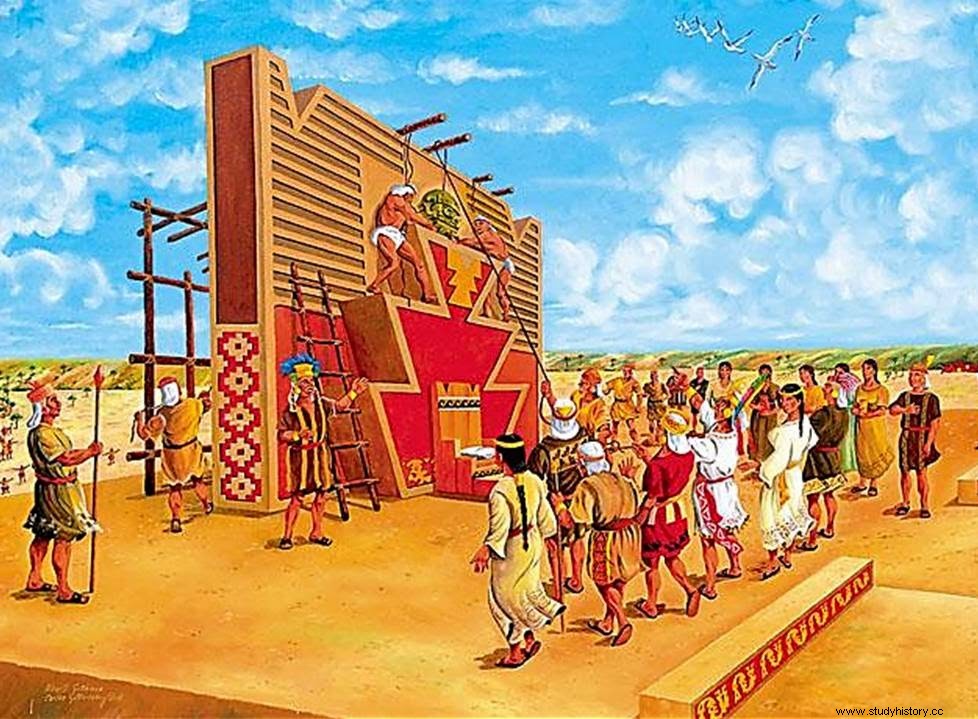
ECONOMIC ORGANIZATION The basis of the livelihood of Sicán - Lambayeque was agriculture, with irrigation canals that are part of the great irrigation system of the entire Peruvian coast. It is an extensive agriculture, with large fields of cultivation. They were also a seafaring people, which not only allowed them to develop fishing, but also to contact large sectors along the coast. Its cotton and camelid wool tapestries are remarkable. Its decorations are colorful and its iconography is very detailed, serving as a means to transmit the ideology of the ruling class. Lambayeque's economy was based on intensive agriculture of corn and cotton by irrigation. During its development in Batan Grande, an advanced system of canals was developed that articulated the valleys of Reque, Chancay, Lambayeque and La Leche. The main canals were three:the raca rumi that linked the chancay rivers with the milk; the old taymi, which irrigated the north and south of the milk valley; and the collique canal, which irrigated the zaña valley.
CULTURAL EXPRESSIONS
A.- ARCHITECTURE The Lambayeque built large monumental complexes where the priest-kings resided, religious worship was conducted and the economy was managed. Due to the size and lack of popular neighborhoods, some scholars prefer to consider them ceremonial centers and not cities (the town lived in their vicinity and only entered to pay tribute or offer to the gods). They were complexes full of pyramids, made of adobe bricks. , all truncated (without vertex or point, just like the Mochicas). Naylamp and his entourage brought architectural knowledge that shaped them in the Huaca Chotuna 6 km from Lambayeque where the main monument (pyramidal) is 15 m high of adobe , has decorations similar to the Huaca del Dragon. The main ones are the following:
HUACA DE TÚCUME It is considered the capital of Lambayeque during the Middle Sicán stage. It is made up of 17 pyramids, higher than 30 m. high, among which stands out:"Huaca Loro", "Huaca las Ventanas", "Huaca La Merced", etc. It not only served as a place of religious worship, where thousands of pilgrims flocked due to its prestige as a ceremonial center, but also an important administrative center, which allowed the priest-kings to consolidate their power.
THE APURLEC This complex is considered one of the largest in ancient Peru and the one that can most closely approximate the category of a city. It is notable for its pyramids, warehouses, and extensive streets, as well as for its canals and cultivated fields in adjoining areas, which indicates that it was an important agricultural production and distribution center (rather than ceremonial, as the previous two were).
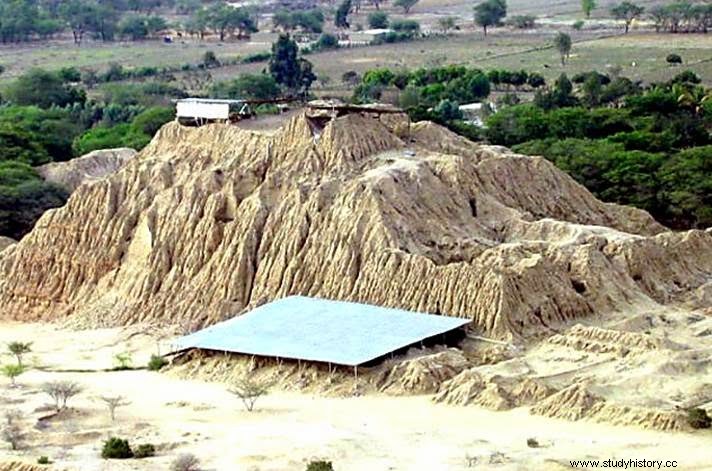 Huaca las rafts de Túcume B.- CERAMICS They used two manufacturing techniques associated with vessels with different characteristics and functions. The utilitarian vessels (pitchers and pots) were made with the paleteado technique, through the use of a trowel and an anvil. Palletizing not only formed and reinforced the walls of the vessel, but also decorated its exterior with figurative and abstract designs. For their part, the fine vessels (bottles with single necks and double spouts) were made and decorated through the use of molds . These vessels were fired in semi-closed, oval-shaped kilns at a temperature that varied between 700 - 900 ºC. In 1985, Izumi Shimada characterized this ceramic chronologically in 3 periods:
Huaca las rafts de Túcume B.- CERAMICS They used two manufacturing techniques associated with vessels with different characteristics and functions. The utilitarian vessels (pitchers and pots) were made with the paleteado technique, through the use of a trowel and an anvil. Palletizing not only formed and reinforced the walls of the vessel, but also decorated its exterior with figurative and abstract designs. For their part, the fine vessels (bottles with single necks and double spouts) were made and decorated through the use of molds . These vessels were fired in semi-closed, oval-shaped kilns at a temperature that varied between 700 - 900 ºC. In 1985, Izumi Shimada characterized this ceramic chronologically in 3 periods: The ancient Sican (750 - 900) characterized by the strong influence of foreign styles such as Cajamarca Medio and Wari/Pachacamac. It constitutes a transition phase between the end of the Moche or the rise of the Sicán. The Middle Sicán (900 - 1100) period that declines Wari, ceramics from this period with the symbol of the Sicán lord, have been found from Ancón and Pachacamac to Isla de la Plata near Guayaquil. The late Sicán (1100 - 1375) the pottery has a perfect burnishing, dark black and spotted black. Expressions of both styles were due to the fact that most of Lambayeque's pottery is black like the Chimú (the area was conquered and annexed to the Chimú culture).
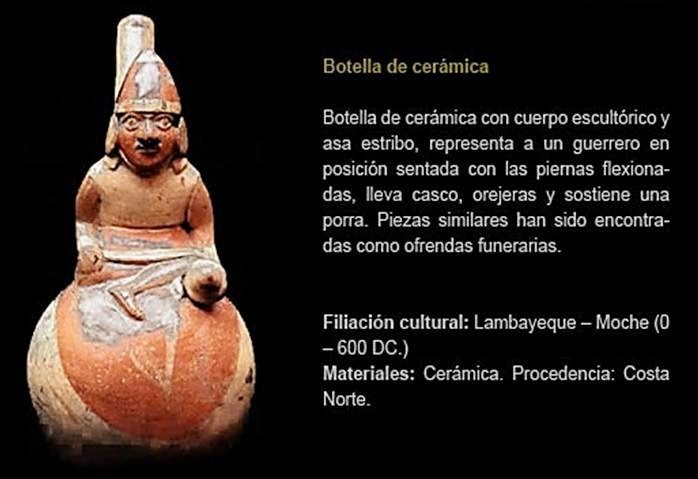
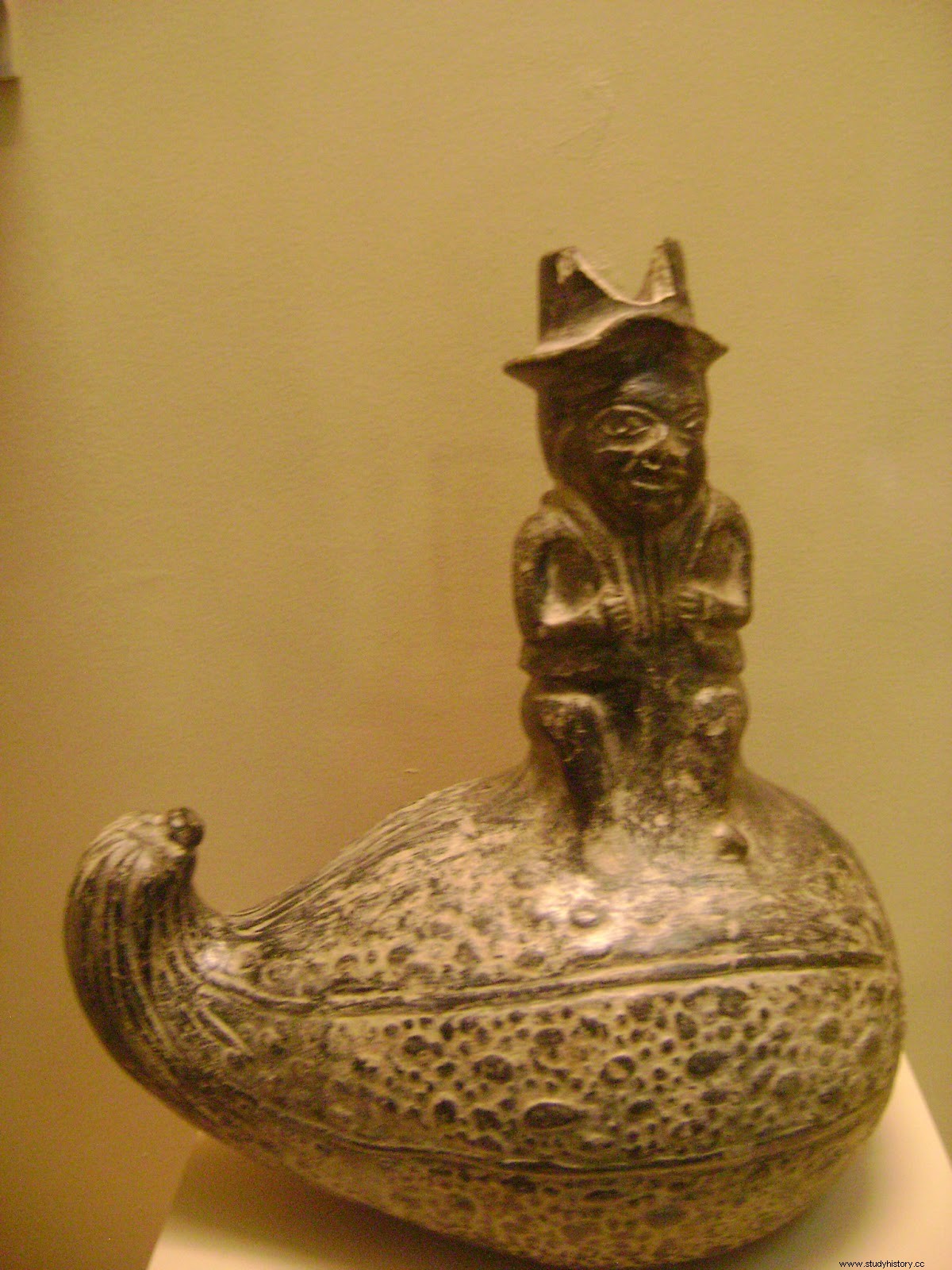
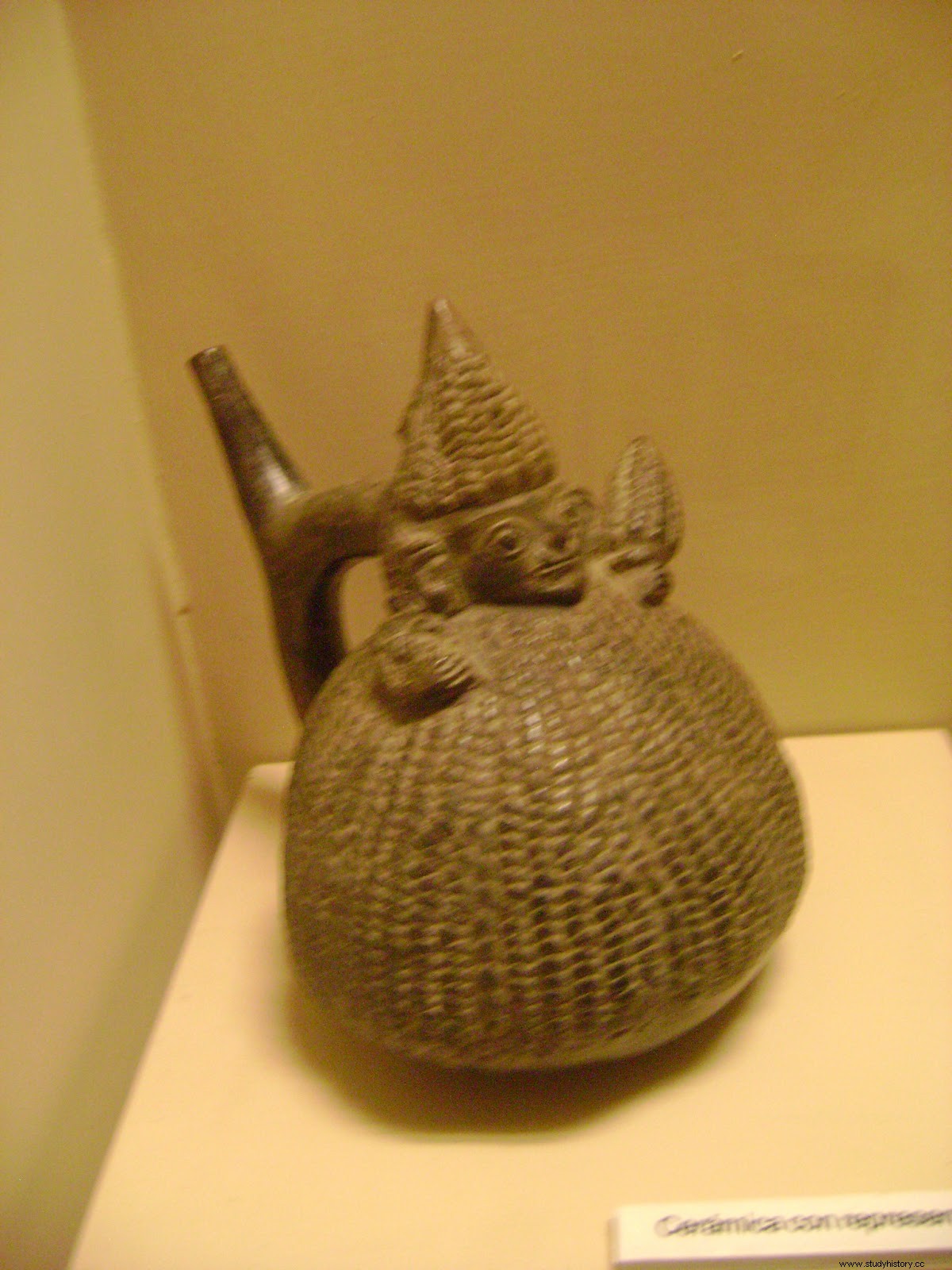
C.- METALLURGY The Lambayeque finely developed metallurgy. They are, due to their work and reasons, the best exponents of all pre-Hispanic cultures in this field. They worked copper, silver and gold with techniques such as casting, rolling, hammering, embossing, chiseling and engraving; they make solders and alloys; in addition to putting bone and stone applications on them. The Sicán Culture began the Bronze Age of northern Peru with the large-scale production of copper arsenic - copper alloy with arsenic - with advanced casting techniques for the time. Then these metals passed into the hands of expert goldsmiths to turn them into the delicate and impressive ornaments of gold and precious stones found in the tombs excavated in Batan Grande. The smelting technique was fueled by carob charcoal abundant in the area. The ovens reached temperatures between 1000 to 1100 degrees centigrade, whose strength to reach it was provided by the lung capacity of several men who spent two to three hours blowing at the same time through reed tubes. The Sican conceived of foundry work as a magical religious activity, since the construction of furnaces was preceded by complicated rituals in which llama fetuses were offered. It was distinguished by the unprecedented scale in the production and use of precious metals. The well-known ceremonial knives (tumis) and gold masks are Sicán objects looted from elite tombs. What is traditionally described as gold or gold alloy are gold-silver-copper alloys ranging from one to 21 carats. Alloys of less than 10 carats are called Tumbaga.
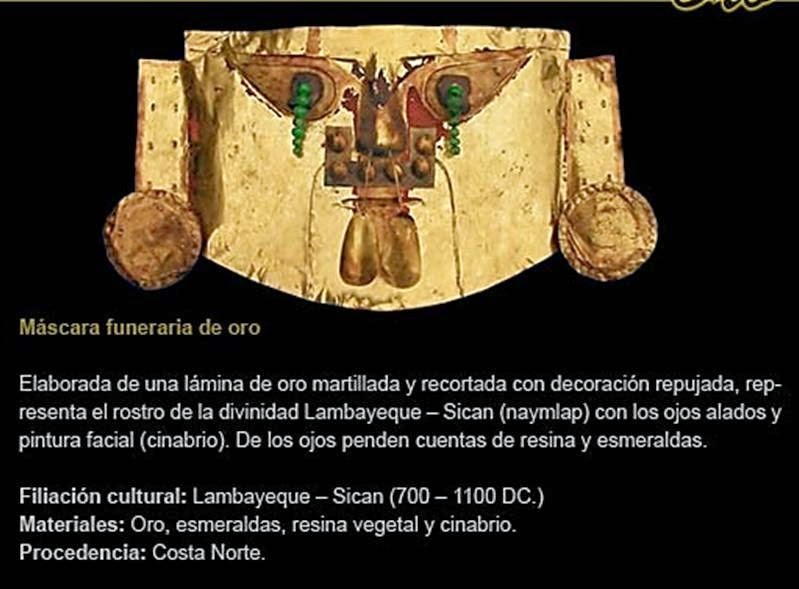
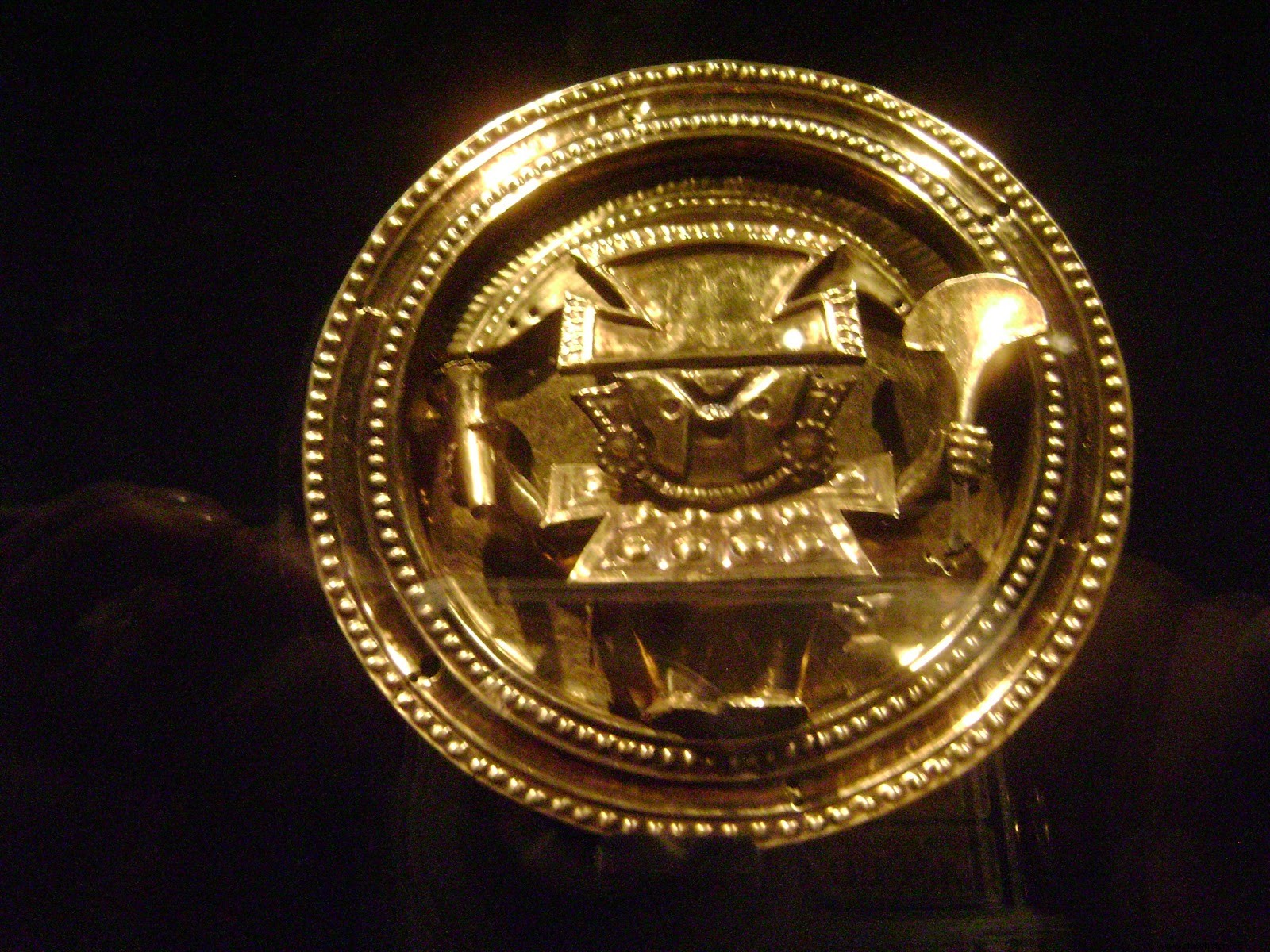 Sicán-Lambayeque Earmuffs
Sicán-Lambayeque Earmuffs 
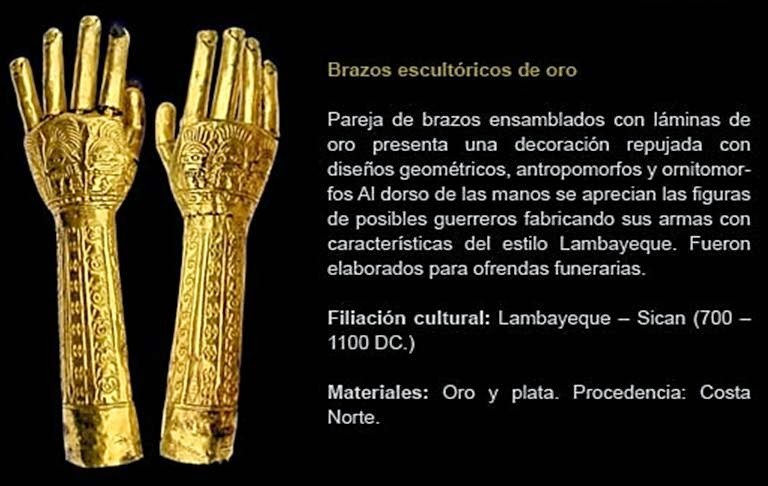

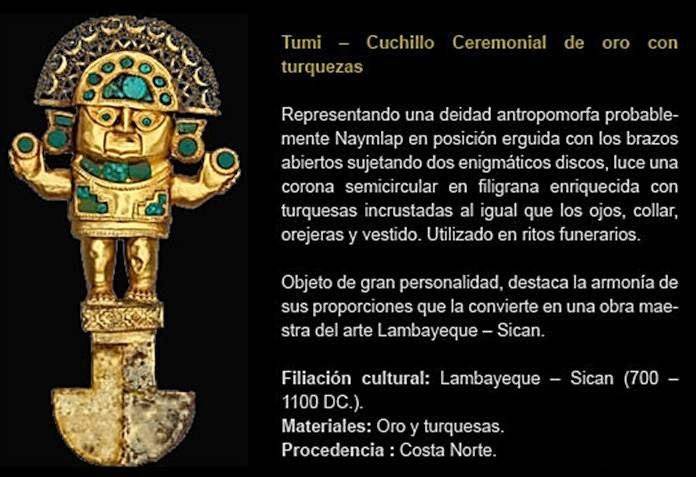
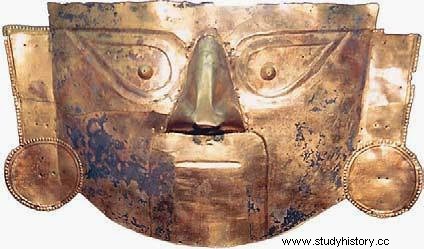 Funeral mask from Sicán- Lambayeque
Funeral mask from Sicán- Lambayeque  Breastplate made of gold D.- FUNERAL PRACTICES The Tombs contained two adult female individuals, two juveniles, and about 1.2 tons of various funerary goods placed around the inverted body of a fully clothed adult male figure placed in the center of the burial chamber. The main character wore a large 14-karat gold mask, with his eyes made of amber and emerald beads. One box contained about 60 ornaments and ritual paraphernalia (crowns, headbands, rattles) made of high-carat gold, gold-silver, and tumbaga. There was also a pile of Spondylus shells (179 specimens) and another of Conus fergusoni (141 specimens). In addition, it contained a bunk covered with gold foil and about 80 kg. of beads made of amethyst, quartz, amber, turquoise and Spondylus shell. A large part of the items found in the East Tomb were of an exotic and imported nature, evidencing the presence of a long-distance exchange network between the Ecuadorian coast and the northern Peruvian coast. These latest data, added to the results of the radar reconnaissance Soil penetration surveys around Huaca Loro suggest that the pyramid was built on top of a series of elite tombs arranged in an orderly fashion. In other words, the monumental structure, and its temple located on top, represented a gigantic tombstone used for rituals related to the cult of the ancestor.
Breastplate made of gold D.- FUNERAL PRACTICES The Tombs contained two adult female individuals, two juveniles, and about 1.2 tons of various funerary goods placed around the inverted body of a fully clothed adult male figure placed in the center of the burial chamber. The main character wore a large 14-karat gold mask, with his eyes made of amber and emerald beads. One box contained about 60 ornaments and ritual paraphernalia (crowns, headbands, rattles) made of high-carat gold, gold-silver, and tumbaga. There was also a pile of Spondylus shells (179 specimens) and another of Conus fergusoni (141 specimens). In addition, it contained a bunk covered with gold foil and about 80 kg. of beads made of amethyst, quartz, amber, turquoise and Spondylus shell. A large part of the items found in the East Tomb were of an exotic and imported nature, evidencing the presence of a long-distance exchange network between the Ecuadorian coast and the northern Peruvian coast. These latest data, added to the results of the radar reconnaissance Soil penetration surveys around Huaca Loro suggest that the pyramid was built on top of a series of elite tombs arranged in an orderly fashion. In other words, the monumental structure, and its temple located on top, represented a gigantic tombstone used for rituals related to the cult of the ancestor.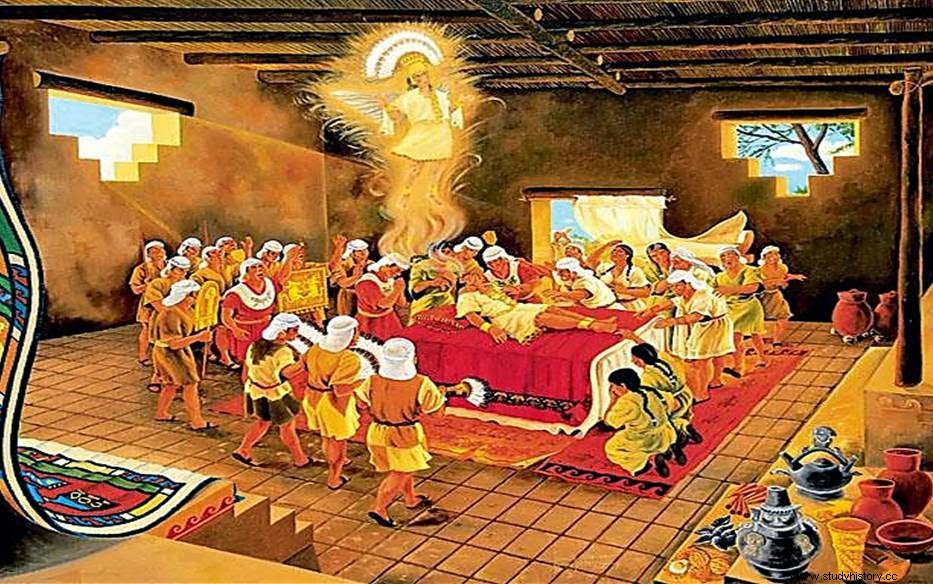
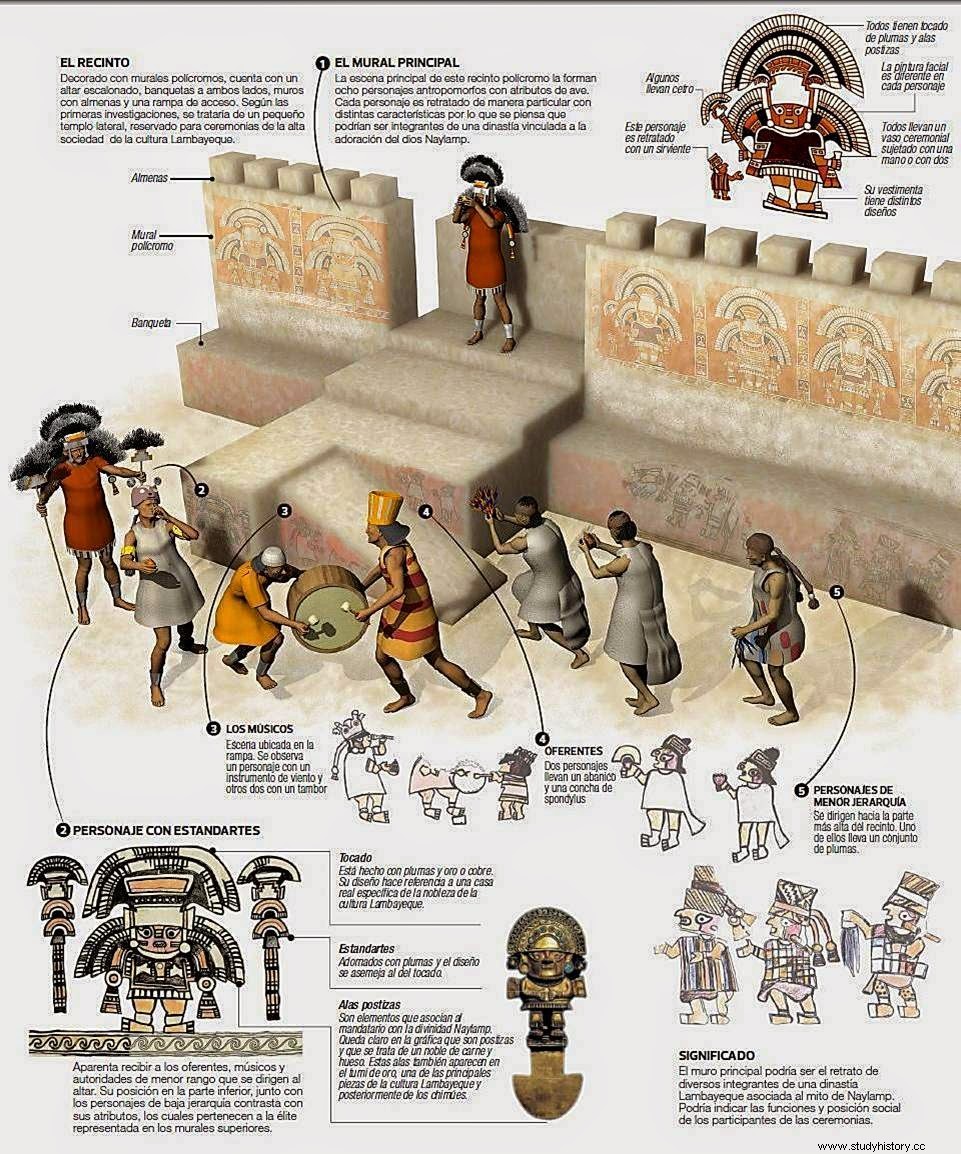 Sicán-Lambayeque Ritual E.- TEXTILES The textiles, the few samples that have been recovered, illustrate the use of native cotton in natural colors, as well as camelid wool fiber. The knowledge of a great variety of techniques such as tapestry, painted fabrics, use of multicolored feathers, etc. was remarkable. The Sicán or Naymlap god appears very frequently represented in the tapestries, as well as the rolls of painted fabrics found in the tombs, which probably served to be placed on the walls of architectural structures associated with the elite. A study has yet to be made. most exhaustive of the Sicán or Lambayeque textile legacy, in terms of technology and rich religious iconography that was represented.
Sicán-Lambayeque Ritual E.- TEXTILES The textiles, the few samples that have been recovered, illustrate the use of native cotton in natural colors, as well as camelid wool fiber. The knowledge of a great variety of techniques such as tapestry, painted fabrics, use of multicolored feathers, etc. was remarkable. The Sicán or Naymlap god appears very frequently represented in the tapestries, as well as the rolls of painted fabrics found in the tombs, which probably served to be placed on the walls of architectural structures associated with the elite. A study has yet to be made. most exhaustive of the Sicán or Lambayeque textile legacy, in terms of technology and rich religious iconography that was represented. 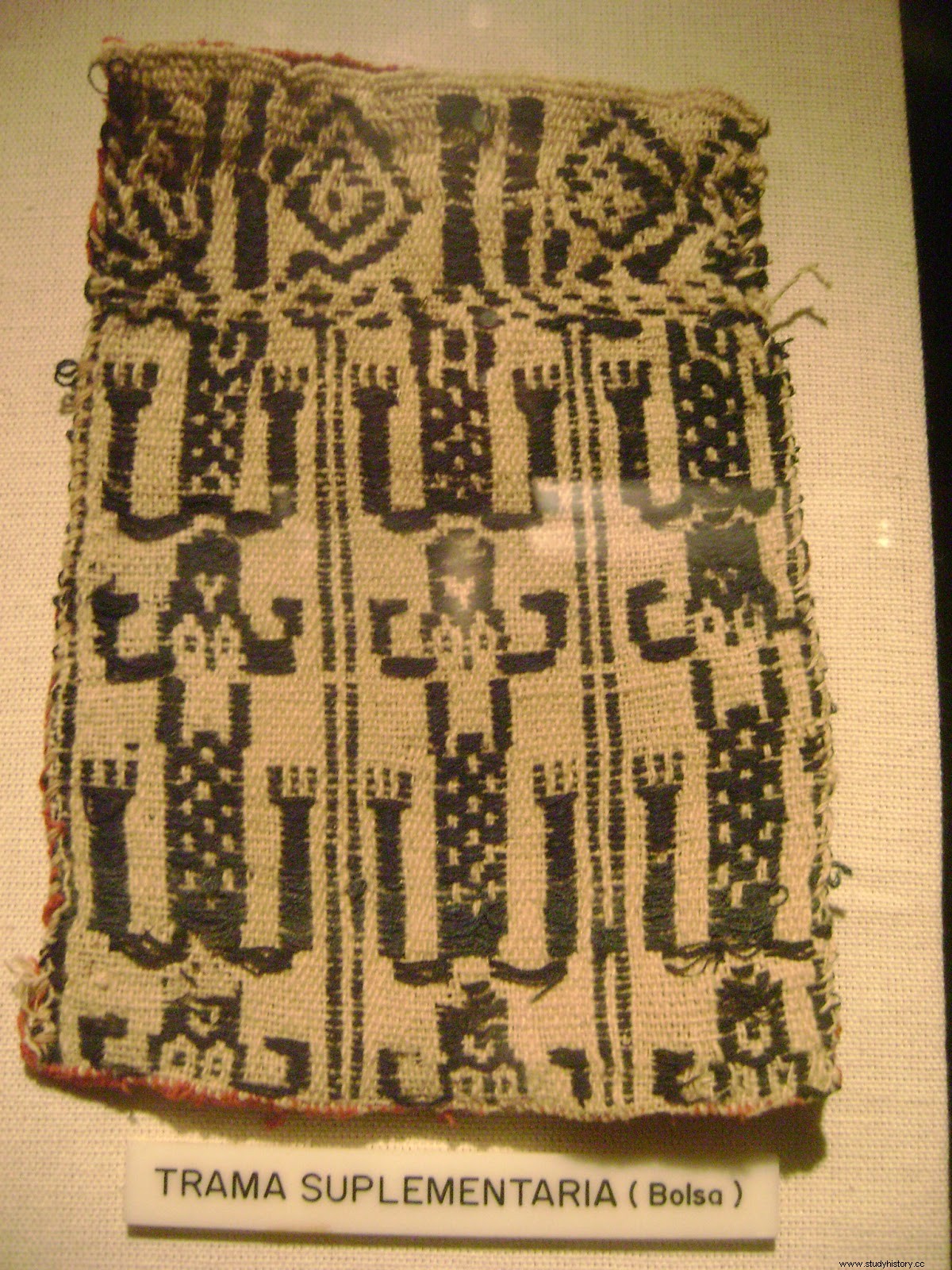 Lambayeque style bag
Lambayeque style bag 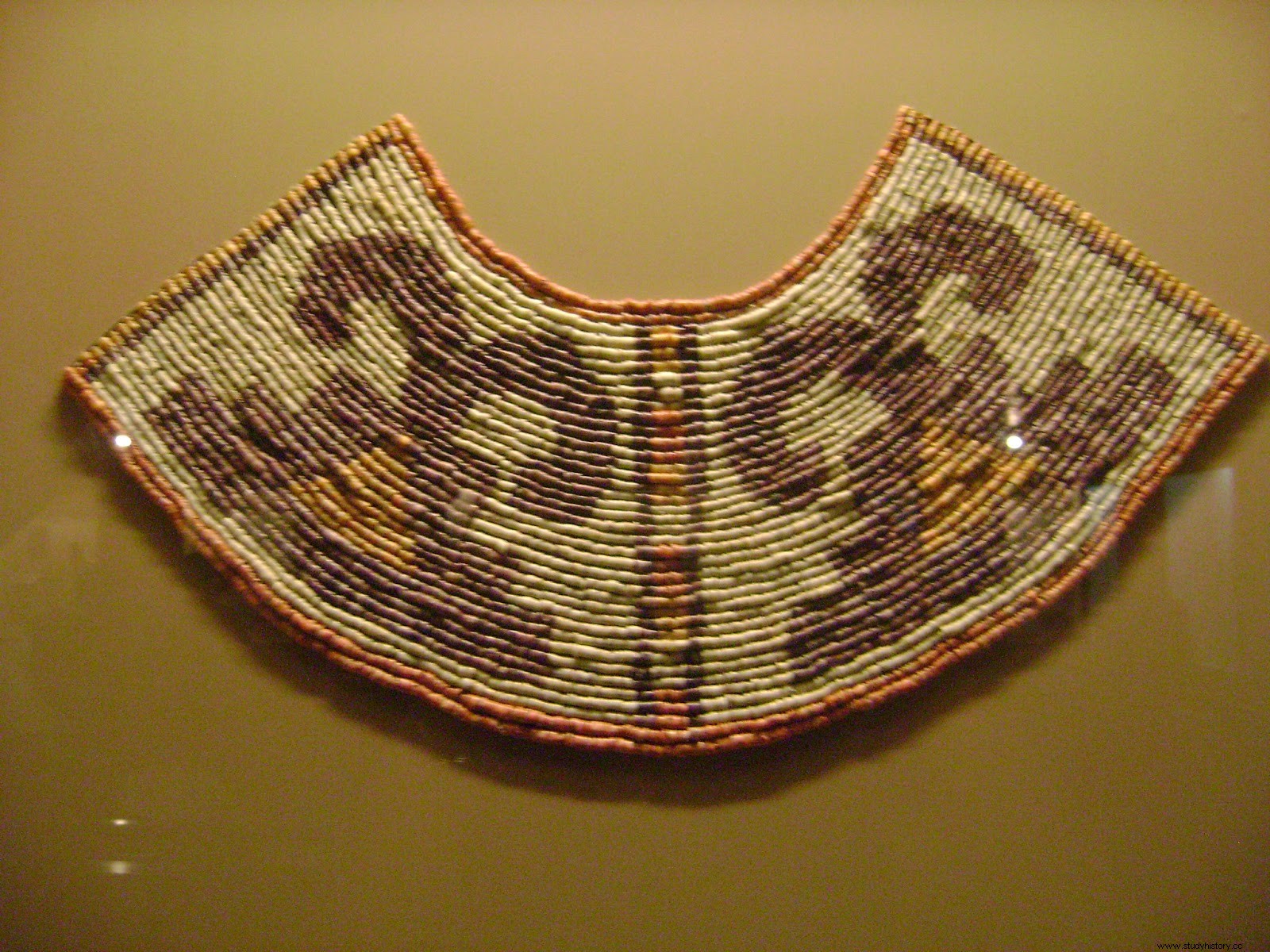
“THE LORD OF SICÁN, THE OTHER FIND ”
Another sensational discovery made in Batán Grande and belonging to the Sicán culture, was the one that took place in 1991; It was carried out by the Japanese archaeologist Izumi Shimada in the Huaca del Loro. There he excavated and documented two elite tombs from the middle period of that culture. The works were carried out from the end of June 1991 to the middle of March 1992 and they are the first elite tombs from this period that have been scientifically excavated. These tombs are located within the National Archaeological and Ecological Reserve of Poma, Batán Grande, in the La Leche river valley, on the north coast of Peru. These tombs had been located during a systematic survey of areas that were looted between 1978 and 1980. The red stains of cinnabar (red pigment - mercury sulfide) and fragments of gold foil left as debris by looters on surface, led to the assumption that the nearby tombs belonged to individuals of high social status. The evidence indicates the high development reached in the fields of metallurgical technology, agriculture and economy that made it possible for Sicán to be a unique culture. Sicán means "House of the Moon" in the ancient Muchick language, and that was the name of the area in which it developed. One of the tombs studied, belonged to an elite man of about 40 to 50 years of age. He was found sitting cross-legged and his body completely covered in cinnabar, which had probably been applied as part of the ritual. The body was upside down and it had been forced to take an angle of almost 180°. On the body he wore innumerable shell beads and semi-precious stones. His attire also included a gold skirt, earmuffs, and a gold mask. Gold had, for the men of this time, a ritual value different from the one we give it today. It served for the adornment and pomp of the Lord, who appeared before his subjects resplendent from him like the sun itself. The Lord was buried with most of his belongings, including the litter that carried him. The highlight is the incredible amount of goods found, mostly metal objects, whose weight reached 1.2 tons, which clearly shows the economic wealth and great productivity, in addition to the technological advance and social organization of the Sicán Culture. The pieces compete in quantity and quality with those of the Lord of Sipán. In 1994, an exhibition of these important finds was held at the Museo de la Nación. A few months ago, the Sicán Museum was inaugurated in Ferreñafe, Lambayeque, where all the pieces have been moved for permanent exhibition.
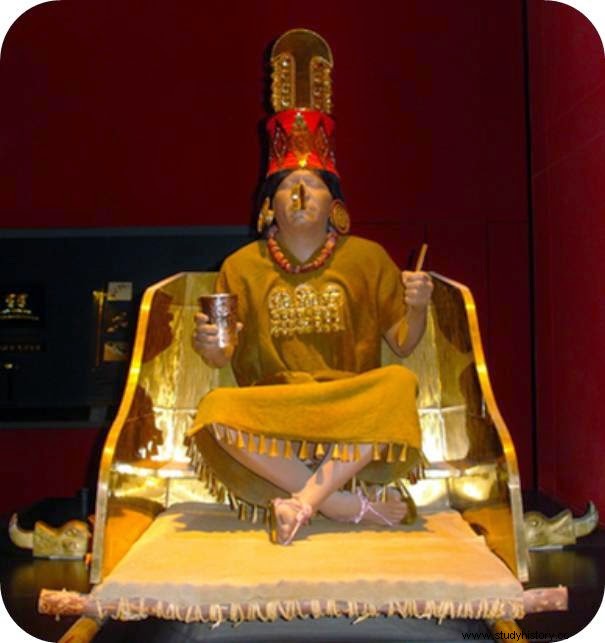 THE LORD OF SICÁN
THE LORD OF SICÁN 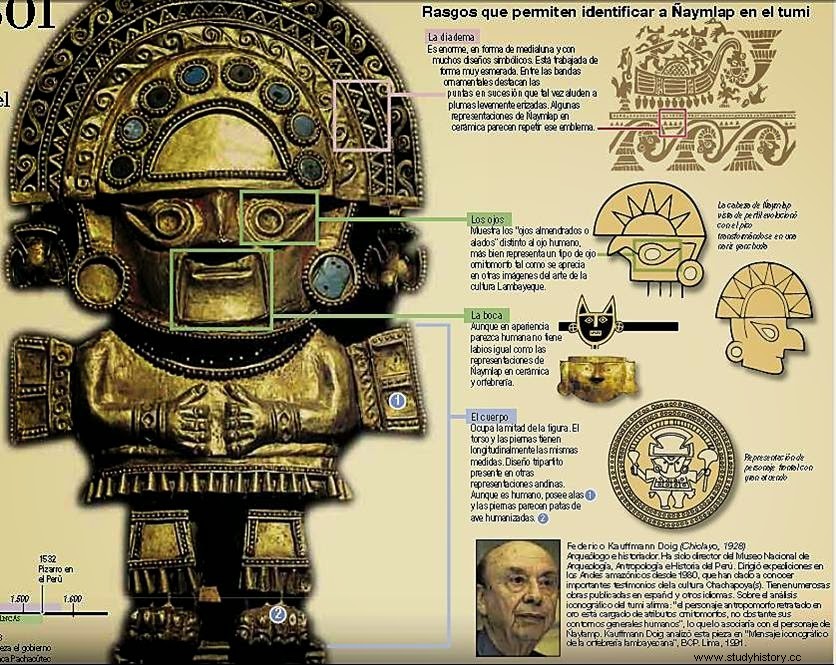 Illimo's Knife Infographic
Illimo's Knife Infographic 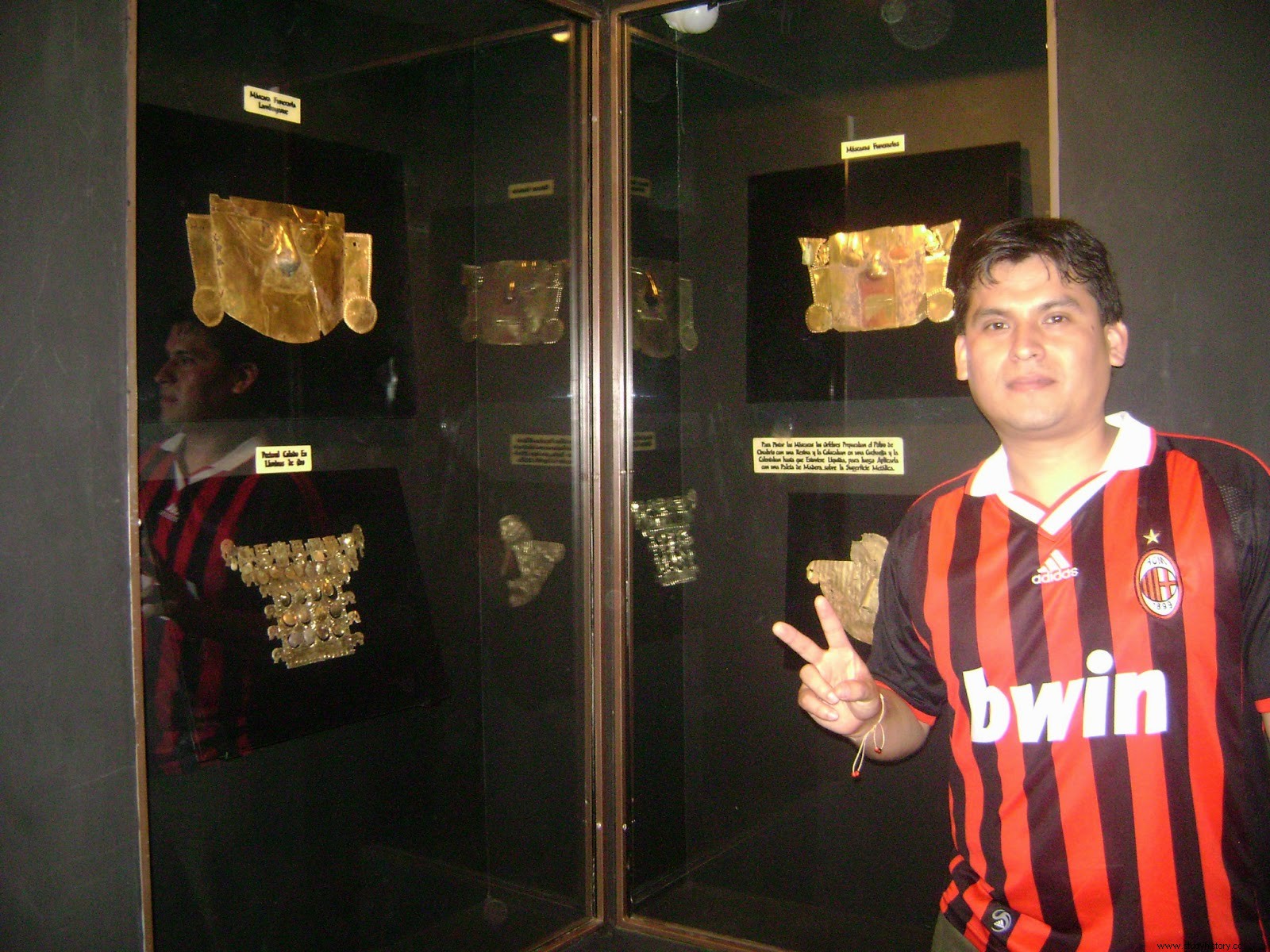 Visiting the Bruning-Lambayeque museum
Visiting the Bruning-Lambayeque museum 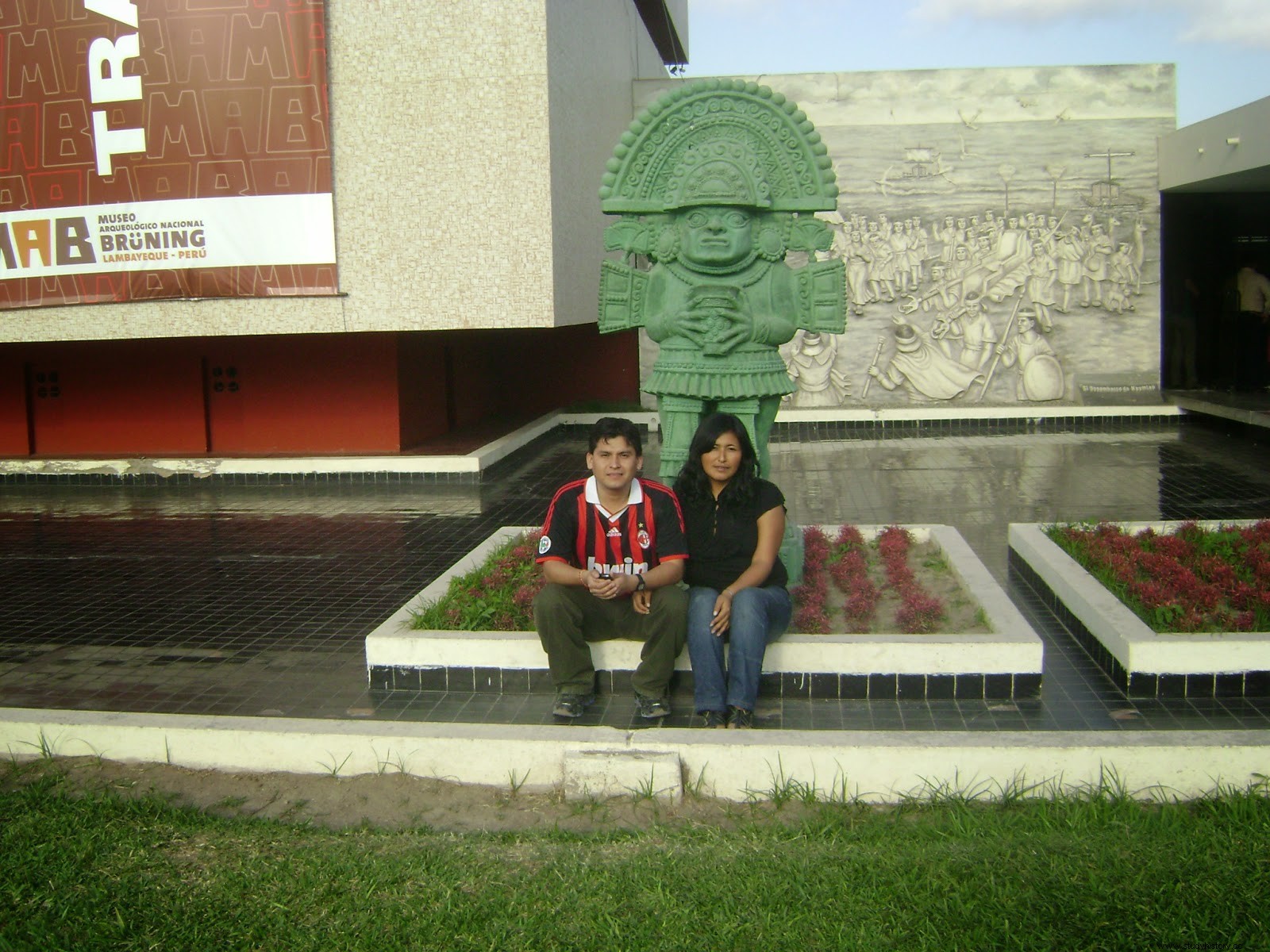 Bruning Archaeological Museum -Lambayeque
Bruning Archaeological Museum -Lambayeque 